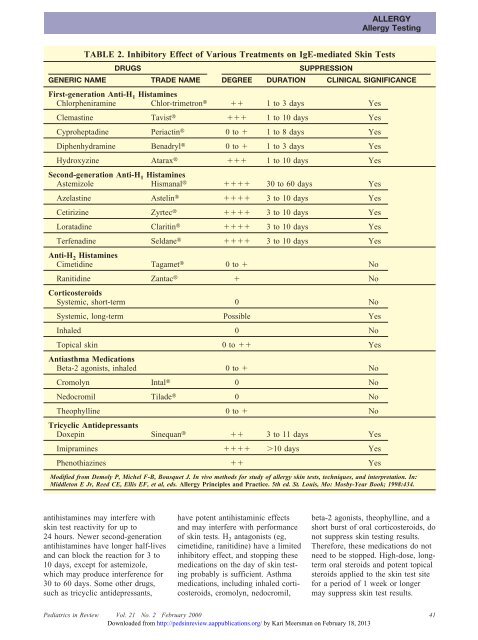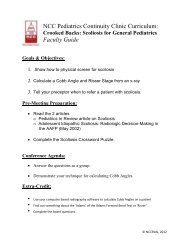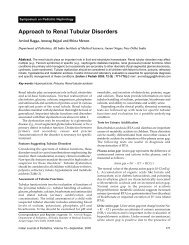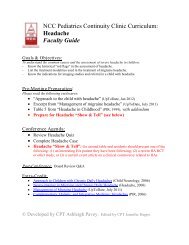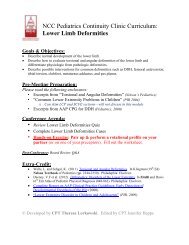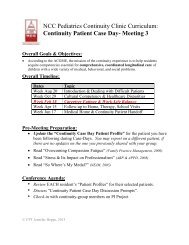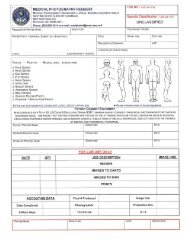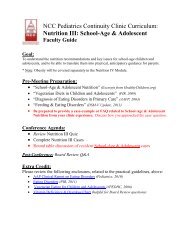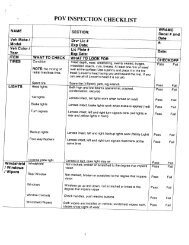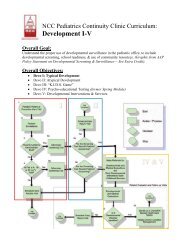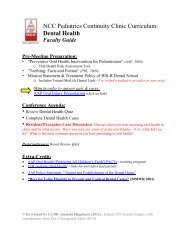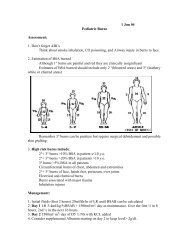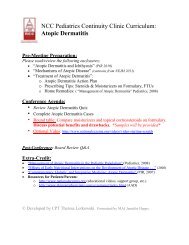Testing for Allergy - NCC Pediatrics Residency at Walter Reed
Testing for Allergy - NCC Pediatrics Residency at Walter Reed
Testing for Allergy - NCC Pediatrics Residency at Walter Reed
Create successful ePaper yourself
Turn your PDF publications into a flip-book with our unique Google optimized e-Paper software.
ALLERGY<br />
<strong>Allergy</strong> <strong>Testing</strong><br />
TABLE 2. Inhibitory Effect of Various Tre<strong>at</strong>ments on IgE-medi<strong>at</strong>ed Skin Tests<br />
DRUGS<br />
SUPPRESSION<br />
GENERIC NAME TRADE NAME DEGREE DURATION CLINICAL SIGNIFICANCE<br />
First-gener<strong>at</strong>ion Anti-H 1 Histamines<br />
Chlorpheniramine Chlor-trimetron 1 to 3 days Yes<br />
Clemastine Tavist 1 to 10 days Yes<br />
Cyproheptadine Periactin 0to 1 to 8 days Yes<br />
Diphenhydramine Benadryl 0to 1 to 3 days Yes<br />
Hydroxyzine Atarax 1 to 10 days Yes<br />
Second-gener<strong>at</strong>ion Anti-H 1 Histamines<br />
Astemizole Hismanal 30 to 60 days Yes<br />
Azelastine Astelin 3 to 10 days Yes<br />
Cetirizine Zyrtec 3 to 10 days Yes<br />
Lor<strong>at</strong>adine Claritin 3 to 10 days Yes<br />
Terfenadine Seldane 3 to 10 days Yes<br />
Anti-H 2 Histamines<br />
Cimetidine Tagamet 0to No<br />
Ranitidine Zantac No<br />
Corticosteroids<br />
Systemic, short-term 0 No<br />
Systemic, long-term Possible Yes<br />
Inhaled 0 No<br />
Topical skin 0 to Yes<br />
Antiasthma Medic<strong>at</strong>ions<br />
Beta-2 agonists, inhaled 0 to No<br />
Cromolyn Intal 0 No<br />
Nedocromil Tilade 0 No<br />
Theophylline 0 to No<br />
Tricyclic Antidepressants<br />
Doxepin Sinequan 3 to 11 days Yes<br />
Imipramines 10 days Yes<br />
Phenothiazines Yes<br />
Modified from Demoly P, Michel F-B, Bousquet J. In vivo methods <strong>for</strong> study of allergy skin tests, techniques, and interpret<strong>at</strong>ion. In:<br />
Middleton E Jr, <strong>Reed</strong> CE, Ellis EF, et al, eds. <strong>Allergy</strong> Principles and Practice. 5th ed. St. Louis, Mo: Mosby-Year Book; 1998:434.<br />
antihistamines may interfere with<br />
skin test reactivity <strong>for</strong> up to<br />
24 hours. Newer second-gener<strong>at</strong>ion<br />
antihistamines have longer half-lives<br />
and can block the reaction <strong>for</strong> 3 to<br />
10 days, except <strong>for</strong> astemizole,<br />
which may produce interference <strong>for</strong><br />
30 to 60 days. Some other drugs,<br />
such as tricyclic antidepressants,<br />
have potent antihistaminic effects<br />
and may interfere with per<strong>for</strong>mance<br />
of skin tests. H 2 antagonists (eg,<br />
cimetidine, ranitidine) have a limited<br />
inhibitory effect, and stopping these<br />
medic<strong>at</strong>ions on the day of skin testing<br />
probably is sufficient. Asthma<br />
medic<strong>at</strong>ions, including inhaled corticosteroids,<br />
cromolyn, nedocromil,<br />
beta-2 agonists, theophylline, and a<br />
short burst of oral corticosteroids, do<br />
not suppress skin testing results.<br />
There<strong>for</strong>e, these medic<strong>at</strong>ions do not<br />
need to be stopped. High-dose, longterm<br />
oral steroids and potent topical<br />
steroids applied to the skin test site<br />
<strong>for</strong> a period of 1 week or longer<br />
may suppress skin test results.<br />
<strong>Pedi<strong>at</strong>rics</strong> in Review Vol. 21 No. 2 February 2000 41<br />
Downloaded from http://pedsinreview.aappublic<strong>at</strong>ions.org/ by Kari Meersman on February 18, 2013


